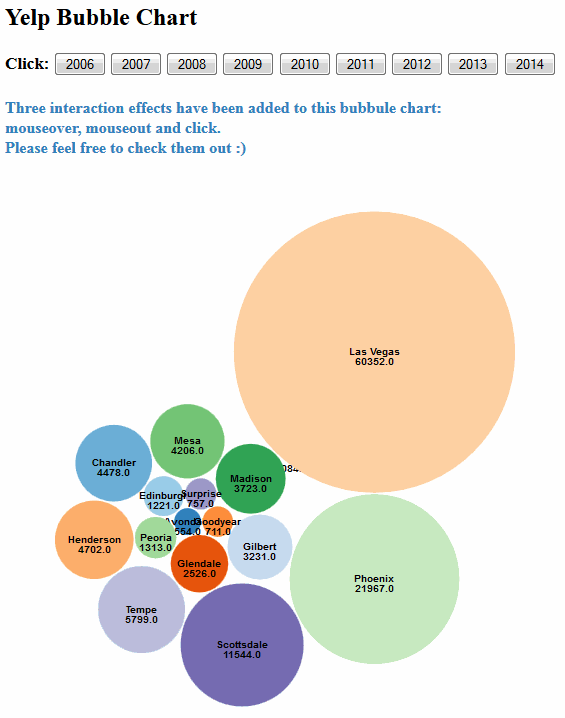еҰӮдҪ•еҲ йҷӨD3ж°”жіЎеӣҫдёӯзҡ„еӨ–еңҲ
жҲ‘иҜ•еӣҫж‘Ҷи„ұж°”жіЎеӣҫзҡ„еӨ–еңҲгҖӮдҪҶе®һйҷ…дёҠзҺ°еңЁжҲ‘зҡ„жңәжҷәе·Із»Ҹз»“жқҹ......дјјд№ҺеҫҲе°‘еңЁзәҝж•ҷзЁӢеҰӮдҪ•дҪҝз”Ёcsvж•°жҚ®з»ҳеҲ¶ж°”жіЎеӣҫгҖӮиҜ·жҹҘзңӢжҲ‘зҡ„е·ҘдҪңPLUNK并帮еҠ©жҲ‘гҖӮ
PLUNKпјҡhttp://plnkr.co/edit/87WLm3OmK1jRtcq8p96u?p=preview
d3.csv("count_s.csv", function(csvData) {
var years = [2006, 2007, 2008, 2009, 2010, 2011, 2012, 2013, 2014];
pack.value(function(d) {
return +d["count" + years[i]];
});
var data = {
name: "city",
children: csvData
};
var node = svg1.selectAll("g.node")
.data(pack.nodes(data), function(d) {
return d.city;
});
1 дёӘзӯ”жЎҲ:
зӯ”жЎҲ 0 :(еҫ—еҲҶпјҡ2)
еңЁжӮЁзҡ„зӨәдҫӢдёӯиҙҹиҙЈеҲӣе»әеңҶеңҲзҡ„д»Јз ҒжҳҜиҝҷж ·зҡ„пјҲж–Ү件bubble.jsпјҢ第63-70иЎҢпјүпјҡ
//Add the Circles
var circles = nodeEnter.append("circle")
.attr("r", function(d) {
return d.r;
})
.style("fill", function(d) {
return color1(d.city);
});
жӮЁйңҖиҰҒеҒҡзҡ„е°ұжҳҜж”ҫиЎҢ
.filter(function(d){ return d.parent; })
append()д№ӢеүҚпјҢеҰӮдёӢжүҖзӨәпјҡ
//Add the Circles
var circles = nodeEnter
.filter(function(d){ return d.parent; })
.append("circle")
.attr("r", function(d) {
return d.r;
})
.style("fill", function(d) {
return color1(d.city);
});
дҪ дјҡеҫ—еҲ°пјҡ

и§ЈеҶіж–№жЎҲзҡ„и§ЈйҮҠжҳҜпјҢж·»еҠ зҡ„иЎҢеҸӘжҳҜд»ҺжёІжҹ“дёӯжҺ’йҷӨд»»дҪ•жІЎжңүзҲ¶зә§пјҲе®һйҷ…дёҠеҸӘжҳҜжңҖеӨ–еңҲпјүзҡ„еңҶеңҲгҖӮ
дҝ®ж”№иҝҮзҡ„жҸ’件жҳҜhereгҖӮ
жіЁж„Ҹпјҡд»ҚдјҡжҳҫзӨәеӨ–еңҲдёӯй—ҙзҡ„ж–Үеӯ—гҖӮеҰӮжһңжӮЁдёҚжғіиҰҒе®ғпјҢжӮЁеҸҜд»Ҙеә”з”Ёзұ»дјјдәҺеңҶеңҲжң¬иә«зҡ„д»Јз Ғи§ЈеҶіж–№жЎҲгҖӮ
зӣёе…ій—®йўҳ
- жҳҫзӨәиЎЁd3.jsдёӯжҜҸдёӘж°”жіЎеӣҫеңҶеңҲзҡ„ж•°жҚ®
- е®һж—¶D3ж°”жіЎеӣҫпјҲеңҶеҪўеҢ…иЈ…пјү
- еҰӮдҪ•еҲ йҷӨD3ж°”жіЎеӣҫдёӯзҡ„еӨ–еңҲ
- d3ж°”жіЎеӣҫеңҲеӯҗз©әзҷҪ并没жңүж¶ҲеӨұ
- ж №жҚ®еңҶзҡ„еӨ§е°Ҹжү“еҢ…ж°”жіЎеӣҫ
- еҰӮдҪ•еңЁd3дёӯж”№еҸҳж°”жіЎеӣҫзҡ„зӣҙеҫ„
- D3.JSж°”жіЎеӣҫ - еҮҸе°ҸеңҶе‘ЁеӨ§е°Ҹж—¶йҮҚзҪ®еӣҫиЎЁ
- еҰӮдҪ•е°ҶURLж·»еҠ еҲ°ж°”жіЎеӣҫпјҹ
- еҰӮдҪ•еңЁD3JS v5дёӯд»ҘеңҶеҪўж јејҸеҪўжҲҗж°”жіЎеӣҫпјҹ
- еҰӮдҪ•еңЁReact Nativeдёӯе®һзҺ°ж°”жіЎеӣҫ/еңҶеҢ…иЈ…пјҹ
жңҖж–°й—®йўҳ
- жҲ‘еҶҷдәҶиҝҷж®өд»Јз ҒпјҢдҪҶжҲ‘ж— жі•зҗҶи§ЈжҲ‘зҡ„й”ҷиҜҜ
- жҲ‘ж— жі•д»ҺдёҖдёӘд»Јз Ғе®һдҫӢзҡ„еҲ—иЎЁдёӯеҲ йҷӨ None еҖјпјҢдҪҶжҲ‘еҸҜд»ҘеңЁеҸҰдёҖдёӘе®һдҫӢдёӯгҖӮдёәд»Җд№Ҳе®ғйҖӮз”ЁдәҺдёҖдёӘз»ҶеҲҶеёӮеңәиҖҢдёҚйҖӮз”ЁдәҺеҸҰдёҖдёӘз»ҶеҲҶеёӮеңәпјҹ
- жҳҜеҗҰжңүеҸҜиғҪдҪҝ loadstring дёҚеҸҜиғҪзӯүдәҺжү“еҚ°пјҹеҚўйҳҝ
- javaдёӯзҡ„random.expovariate()
- Appscript йҖҡиҝҮдјҡи®®еңЁ Google ж—ҘеҺҶдёӯеҸ‘йҖҒз”өеӯҗйӮ®д»¶е’ҢеҲӣе»әжҙ»еҠЁ
- дёәд»Җд№ҲжҲ‘зҡ„ Onclick з®ӯеӨҙеҠҹиғҪеңЁ React дёӯдёҚиө·дҪңз”Ёпјҹ
- еңЁжӯӨд»Јз ҒдёӯжҳҜеҗҰжңүдҪҝз”ЁвҖңthisвҖқзҡ„жӣҝд»Јж–№жі•пјҹ
- еңЁ SQL Server е’Ң PostgreSQL дёҠжҹҘиҜўпјҢжҲ‘еҰӮдҪ•д»Һ第дёҖдёӘиЎЁиҺ·еҫ—第дәҢдёӘиЎЁзҡ„еҸҜи§ҶеҢ–
- жҜҸеҚғдёӘж•°еӯ—еҫ—еҲ°
- жӣҙж–°дәҶеҹҺеёӮиҫ№з•Ң KML ж–Ү件зҡ„жқҘжәҗпјҹ